
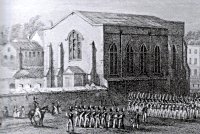
In 1866 a new Chaplain to the Forces was installed at the Domus Dei or Garrison Church on Governor's Green. Archdeacon Henry Press Wright had arrived at a most auspicious moment in the history of the church. Since the time of Lord Frederick Fitz-Clarence in 1851 the concensus had it that the Garrison Church was in urgent need of restoration and by 1866, thanks largely to the efforts of the former Lieutenant-Governor Lord William Paulet and The Rev. JE Sabin, Chaplain to the Forces, the work was being addressed.
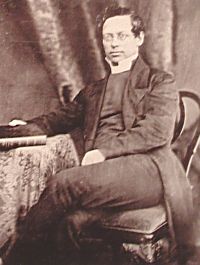
Wright was immediately co-opted onto the Executive Committe which was composed of many of the illustrious men of the day, including Admirals Seymour, Pasley and Chads and Generals Foster, Gordon and Mould. Wright's precise role in the restoration is unclear but as the incumbent he would plainly have had some influence. What is not in doubt are his contributions, firstly to the fabric of the interior, in that his mark is clearly evident in the choice of memorials erected in the new church, but secondly, and perhaps more importantly, that he wrote the first definitive history of the church's origins, a work that was held in high esteem by no less a luminary than the antequarian Sir Frederic Madden (See Portsmouth's Early Historians) who acted as occasional adviser to Wright.
Wright was around 50 years of age when he was appointed to the Garrison Church (there is some debate about his date of birth). His previous experience as Chaplain to the Forces over 24 years placed him close to the apex of the Army Chaplaincy and it was his most ernest ambition to accede to the role of Chaplain General. In many respects he would have been an ideal candidate for the post having served the Chaplaincy at home and abroad on a number of highly significant occasions.
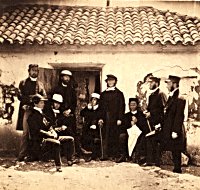
His most outstanding achievement was to serve as Senior Chaplain to Lord Raglan's army throughout the Crimean War. His must have been a grim campaign, committing the bodies of thousands of servicemen to their graves over the two years it took to secure Sevastopol. Remarkably his most prominent role in the war is barely mentioned by historians who, when recording the death of Lord Raglan, are happy to report the names of all the officers present but then go on to baldly state that "the chaplain was called in to read the last rites". That chaplain's name was Henry Press Wright.
After the war he served the Army in a number of positions until in 1861 he was appointed to the new colonies in Vancouver, Canada where he adopted the role of Archdeacon, a title he retained until his death. By all accounts he acquitted himself well in what were rather primitive conditions. He returned to England in 1865 and was appointed to the Garrison Church shortly afterwards.
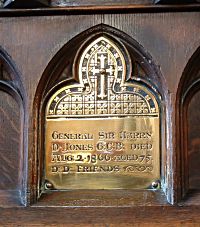
Wright's influence in the newly restored church is perhaps most evident in the choice of subjects for the array of new memorials that were erected. In the chancel 42 new, ornately carved, oak pews were installed, each with it's own memorial plaque attached (see photo). In the nave some 55 new benches were purchased almost all of which had plaques at the aisle end and in the centre of the upright. In addition a number of new windows were commissioned. Practically all of the memorials carry both the name of the remembered serviceman or men and the name of the person dedicating that memorial. What is surprising about these plaques is that apart from a few of the chancel pews, all of the them are dedicated to men who fought in the Crimean War and, in a significant number of instances, were to men that Wright knew personally. Further details of the plaques are available on the Memorials in Portsmouth website
For ten years Henry Press Wright held the post of Chaplain at the Garrison Church during a period of much change in Portsmouth, beginning in 1870 when the demolition of the fortifications, that had cut off the town from the rest of Portsea Island, began. This was also a time of change in the way the army and navy rank and file were treated with much more attention been placed upon pastoral duties. Into this setting there arrived a character who was to have an unfortunate influence on Wright's career.
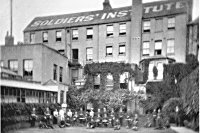
Miss Sarah Robinson was not a native of Portsmouth but took it upon herself to evangelise amongst the men whom she saw as deprived of spiritual sustenance, due in main to the prevalence of alcohol and the lack of suitable accommodation. She set about the establishment of a Soldiers Institute close to the Garrison Church in High Street and there, in a strictly teetotal environment, conducted Bible reading classes. Wright took great exception to this, maintaining that it was the sole right of the army to preach to the men under it's command. The struggle between these two characters was somewhat acrimonious and could only have been resolved by the intervention of the military hierarchy. Sadly for Wright he did not receive the backing he felt was justified and in hindsight it is easy to see why, Miss Robinson already had three Major-Generals signed up as trustees of the Soldiers Institute and was able to continue her mission unchallenged.
It was at this moment that the head of the Army Chaplaincy, Prebendary Gleig, decided to retire; the very chance that Wright had been waiting for. He was undoubtedly the most senior chaplain at that time and it seemed almost a formality that he would be appointed to the post he craved. To his great dismay the job went instead to Bishop Claughton who, to add further insult, was not even an army chaplain. Wright was outraged, writing to Prebendary Gleig a most intemperate letter (April 13 1875) which probably confirmed in Gleig's mind that they had been correct in overlooking Wright's claims to the post. It is not known to what extent, if any, the confrontation with Miss Robinson had in the decision, but Wright's reaction to the new attitude of care for the soldiers could not have helped. It is perhaps indicative that of all the memorials he helped to erect in the church there are none to individual soldiers below the rank of Lieutenant.
Disillusioned, Wright returned to Canada for the next three years, a stint that was notably less successful than the first as he failed to establish a good relationship with his fellow members of the clergy. In 1880 he returned to England where he obtained the rectorship at St John the Baptist Church in Greatham, north of Portsmouth. The fact that his wife's family had recently taken up patronage of the parish can hardly have been coincidental. There Wright pursued his fascination with memorials by ensuring that nine windows in the newly constructed church were dedicated to members of his family (see www.hampshirechurchwindows.co.uk)
Archdeacon Henry Press Wright died on September 10th 1892 whilst on a visit to Liss. He is buried in the old graveyard of the former church with his first wife Anne. His second wife Marian arranged for a plaque dedicated to Wright to be erected in the Garrison Church, on an additional pew in the chancel. The given birth and death dates are at variance with evidence available elsewhere. Marian died on 10 July 1917 at 36 Beach Road, Southsea.
Tim Backhouse
Southsea, 2007
REFERENCES
"The Story of the Domus Dei" by Henry Press Wright
"A Mingling of Priest and General" by Frederick CE Wright
"Close to the Russian Gun" by Frederick CE Wright
"Henry Press Wright: First Archdeacon of Columbia" by Donald H. Simpson
"Yarns" by Sarah Robinson
ADDITIONAL MATERIAL
National Library of Scotland, Department of Manuscripts
Royal Army Chaplains Department
Nicholas Morrison
Cynthia Sherwood